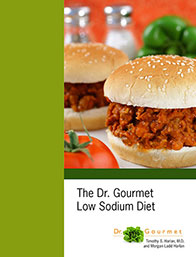It's easy to get answers about health and nutrition! Just send your question by email to [email protected] and Dr. Harlan will respond to selected questions of general interest. Answers will be posted in the Ask Dr. Gourmet newsletter (sign up now!) and archived in the Ask Dr. Gourmet section of the website.
Please note that the Ask Dr. Gourmet feature is restricted to questions regarding food and nutrition. Due to the many questions we receive, not all questions may be answered. For more specific questions about your individual health, please contact your doctor. About Timothy S. Harlan, MD, FACP, CCMS | Terms of Use | Privacy Policy
The Dr. Gourmet Low Sodium Diet

Following a Low Sodium Diet Can Be Delicious!
With The Dr. Gourmet Low Sodium Diet, you'll find that reducing your salt intake doesn't have to mean bland, boring food.
Using The Dr. Gourmet Low Sodium Diet, you'll receive six weeks of healthy menus that are full of flavor. This book includes:
- Reliable information based on sound science about the effects of salt on your heart and health
- 6 weeks of complete meal plans
- 6 weeks of shopping lists, making grocery shopping quick and easy
- 80+ delicious low sodium recipes
- Ingredient and cooking tips throughout the book
- Complete Nutrition Facts for each recipe
Now Available! Paperback: $19.95 + s/h | PDF: $14.95
Ask Dr. Gourmet
Are there low-salt chili powders?
While watching my salt intake I noticed that some commercially-produced chili powders contain lots of salt. Do you know of any low salt brands or have a good recipe for making my own mix?
Dr. Gourmet Says...

In our Culinary Medicine classes one of the first things we teach is about spice blends. The reason is exactly the one that you mention: prepackaged versions often have a lot of added salt. It is not that salt is bad for you, but too much salt is and either making your own spice blend or being careful about which of the pre-made versions you choose puts you in control of how much salt is actually added to your recipe. This holds true for chili powder, Cajun blends, taco spices, jerk seasoning and others.
McCormick Taco Seasoning Mix, for example, contains a whopping 380 milligrams of sodium per serving. The interesting thing is that while the package is labelled "Original Taco Seasoning Mix," the ingredients are essentially a chili powder with added salt. You can purchase the McCormick chili powder at Walmart for about 24 cents per tablespoon vs. 44 cents per tablespoon for the McCormick taco seasoning mix. So it is cheaper to purchase chili powder without salt rather than the pre-packed mixes.
Chili powder itself is actually a blend of ingredients and not a single spice. Depending on the brand or the recipe, ingredients can include cayenne pepper, cumin, garlic powder, oregano, and other spices. Some include salt and others don't. Because the chili powder blend is proprietary to a particular manufacturer, the flavors can vary pretty widely as there is no set recipe. Some can be mild and others pretty spicy.
If you want to make your own, here's a great starting point:
1 tablespoon paprika
1 tablespoon smoked paprika
2 tablespoons oregano
1 tablespoon ground cumin
1 teaspoon garlic powder
1 teaspoon onion powder
1/2 teaspoon cayenne pepper
If you start with this and find it not spicy enough, add more cayenne pepper (or less if you like a milder spice). I prefer a lot more smoked paprika and don't add as much garlic or onion powder for my preferred blend. Some of my Dr. Gourmet recipes use chili powder and others simply use a combination of spices to get a more particular flavor. There are recipes that contain both — chili powder along with additional smoked paprika, cumin, oregano, etc. Recipes provide a framework to create a dish for yourself and this is especially true with seasonings. The herbs and spices you select are what can really make the dish your own.
With respect to choosing a pre-made chili powder, one of the most popular on the market is McCormick. It does contain added salt. At first glance it seems like not a lot, with only 20 milligrams of sodium in a 1/4 teaspoon serving. Most recipes will call for a tablespoon or more in a dish that serves four, so you could be talking about a fair amount of added salt. That tablespoon of their chili powder will actually contain 240 milligrams of sodium, which works out to an additional 60 milligrams of added salt. Again, cheaper to make your own and you will also control both the added salt and get exactly the flavor you prefer.
The two chili powders that I generally purchase are the Whole Foods Market 365 brand or the Simply Organic brand. The latter is more expensive, but is more widely available. Both have great flavor, with neither being too spicy, and they don't contain added salt. I have a friend of mine who swears by Penzeys Spices and won't use anything else. I have not had their chili powder, but it is also salt free.
Thanks for writing,
Eat well, eat spicy, enjoy life!
Timothy S. Harlan, MD, FACP, CCMS
Dr. Gourmet
